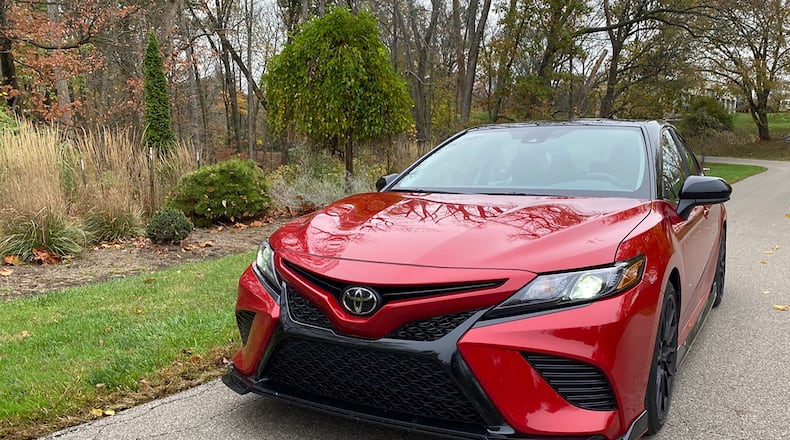During the last couple of weeks I drove a RAV4 and a Camry with TRD trims.
On the bigger vehicles like SUVs and trucks TRD is less about racing and more about off-road ruggedness. In the RAV4, adding the TRD package changes the look of this popular SUV. It even gets its own suspension — ideal for going off the road.
On the Camry, the TRD trim absolutely changes it into something sporty, sexy and youthful. When I saw the Camry TRD up close, I asked, “Who do you think you are?” It’s that much more stunningly attractive.
Toyota is wise to target the TRD this way. It brings in a new, youthful buyer. The Camry TRD has a vibrant, race-car-like vibe, complete with rear fin/spoiler.
The Camry TRD gets more power and performance with a 3.5-liter V6 engine that creates 301 horsepower and 267 lbs.-ft. of torque. The V6 breathes easier with a TRD-tuned cat-back dual exhaust, giving a throatier idle and acceleration sound.
Several times I had to check to make sure I was behind the wheel of a Camry, because it sure didn’t drive like one, nor did it look like one.
Likewise, the RAV4 TRD has such a distinct look with TRD badging and accents all over the exterior and the interior. Unlike the Camry, the RAV4 with TRD trim doesn’t get more power as all 2020 RAV4s have a 2.5-liter four-cylinder engine with 203 HP. It feels underpowered, although the 8-speed automatic helps to redeem the SUV’s performance.
As a TRD, the RAV4 gets improved ground clearance torque-vectoring steering and hill descent control. If you’re not going to take the RAV4 TRD off-roading, it may not be worth the investment, unless you just like its more rugged looks. I certainly enjoyed the appearance, too.
The interior is where both vehicles really separate themselves and show why the TRD trim is so special. On the Camry, the TRD interior is almost garish, but in a good way. It’s bold and dynamic, two adjectives rarely used with a Camry interior.
The cabin is decked out with Black Sport SofTex-trimmed front seats with fabric inserts, red accents and red-stitched TRD embroidered headrests. The leather-wrapped steering wheel also has red stitching, and even the seatbelts are red. A shift knob with an embossed TRD logo, along with unique TRD floor and trunk mats, and a TRD MID visual start-up complete the cabin upgrades.
Generally, racing-style seats are not comfortable for a middle-aged/old guy like me, but I found these seats to be incredibly comfortable. I definitely found the overall TRD interior to be sexy and appealing.
Similar features, although more toned-down, are found inside the RAV4 TRD. The over-the-top, in-your-face styling additions on the Camry play well for that car and I feel like it might’ve been unnecessary and too much for the RAV4.
The RAV4 TRD actually has better fuel economy. It has an EPA rating of 25 mpg/city and 33 mpg/highway. Meanwhile, the Camry TRD has a rating of 22 mpg/city and 31 mpg/highway. In a week’s worth of heavy-footed driving, I averaged 25 mpg in the Camry and got nearly 28 mpg in the RAV4.
The Camry TRD has a base price of $31,040 which I thought was good value for a car that looks so hot and drives so sporty. Final MSRP of my Camry tester was $32,920. The RAV4 TRD had a base price of $35,280.
Toyota added a TRD trim to the otherwise pedestrian Avalon this model year, too. So, if you have been sleeping on Toyota due to some uninspiring model years, TRD injects energy and performance into a solid product line, with Camry leading the way.
Jimmy Dinsmore is a freelance automotive journalist.
2020 TOYOTA CAMRY TRD
- Price/As-tested price................................................ $31,040/$32,920
- Mileage.......................................... 22 mpg/city; 31 mpg/hwy
- Engine............................................. 3.5-liter V6
- Horsepower................................. 301 hp/267 lbs.-ft.
- Transmission................................. 8-speed automatic
- Drive wheels................ Front-wheel drive
- Final assembly point................ Georgetown, Kentucky
About the Author
